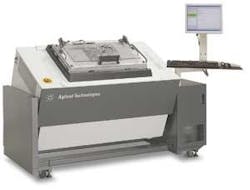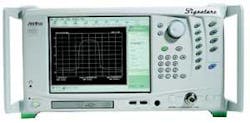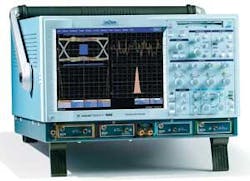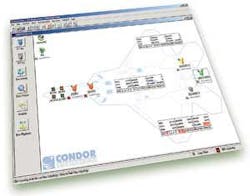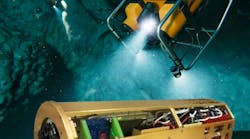Designers of test and measurement equipment for military applications are investing more and more dollars into software and modular designs to improve ease of use and lower costs.
By John McHale
Military purchasers of test and measurement equipment, as in other markets, are demanding higher performance at lower costs and with greater ease of use. However, bringing the latest and greatest off-the-shelf equipment on line also brings the specter of obsolescence.
“Military customers don’t want change,” says Marty Leeke, marketing program manager at Agilent, noting that the assumption is they will keep buying this equipment for 20 years.
The technology is going to evolve over that time and the key to maintaining these military systems is through compatibility. One way to do this is through software that is independent of hardware, which makes it easier to use and easier to train users of test equipment, Leeke explains. The bottom line is that these are more sophisticated solutions, Leeke says.
Today’s test systems for printed-circuit-board assemblies also need to be easy to use because of the economic climate, Leeke says. High employee turnover is reducing the level of training, knowledge, and real-world experience on the production line of today’s electronic manufacturers, Leeke says. Profit margins are shrinking, leaving less money to invest in training for test engineers and operators, and less money to keep maintenance technicians or repair personnel on staff. Today’s electronics manufacturers must do everything right to remain profitable: boards must ship sooner, at lower cost, with quality assured, and with fewer in-house resources to make it happen.
Outsourcing is the solution that many are turning to and test equipment is being outsourced more and more.
The Agilent Medalist i5000 In-Circuit Test (ICT) system is the company’s offering in Agilent’s ICT lineup. This system is designed to accelerate the time to money while verifying the quality of PCBAs. Its advantages include: simpler operation; faster, easier deployment; lower cost of entry; transportable tests for operational flexibility; stable, repeatable test for consistent quality control; and localized maintenance, service, and support worldwide.
It has the functional depth for standalone quality control on complex PCBAs, or can be deployed as part of a larger test and inspection strategy alongside Agilent automated optical inspection (AOI) and automated x-ray inspection (AXI) systems.
Modularity and PXI
Modular installation is a main trend today in test and measurement, says Greg Caesar, PXI product marketing manager for National Instruments in Austin, Texas. It makes it easier to solve obsolescence problems by enabling the plug-and-play hardware upgrades and keeping the hardware independent of the software.
An example of this is National’s PXI products, Caesar says. Customers are choosing increasing numbers of PXI-based applications; PXI-short for PCI eXtensions for Instrumentation-is a modular, 3U form factor that is smaller and faster than its predecessor, PCI.
The company’s NI PXI-5670 is a 2.7-GHz RF vector signal generator offers 16-bit resolution at 100 megasamples per second, backed up by 256 megabytes of memory and 22 MHz of bandwidth.
Caesar says a recent Frost & Sullivan market study has sales of PXI technology increasing about 45 percent in 2004.
Avionics test
Avionics test equipment designers also see easy-to-use software tools as the future.
Rick Schu, vice president of sales and technical officer at Condor Engineering in Santa Barbara, Calif., says Condor engineers are working toward combining open-system test tools in a general IT environment. The key challenge is to bridge the gap in deterministic avionics system with IT systems that are not so robust, Schu says. There are so many nice tools available, that it makes complete sense to take advantage of them.
The answer is in the software to get the real-time capability and determinism from IT tools that are necessary for avionics applications, Schu explains.
Condor Engineering’s BusTools/1553 is an avionics tool for Windows XP, 2000, Me, NT, 98, and 95. This software harnesses the power of Condor’s hardware interfaces on PCI, CompactPCI, PCMCIA, PC/104, PC/104-Plus, PC/AT, VME, and VXI. Supported Condor hardware includes: QPCI-1553, PCI-1553, QCP-1553, CPCI-1553, ISA-1553, QPMC-1553, PMC-1553, PCCARD-D1553, PCCARD-1553, QVME-1553, VME-1553, QVXI-1553X, VXI-1553, and modular solutions.
BusTools/1553 provides comprehensive monitoring, data logging, and BC/31-RT simulation for 100 percent bus loading activity for one or more dual redundant channels. It also provides simultaneous real-time data displays and archiving.
The main technology push in avionics is toward Ethernet technology, Schu says. There is a minor spike toward FireWire and Fibre Channel, but Ethernet is where everyone will go-it is the most widely used and lowest cost technology, he adds.
Data Device Corp. in Bohemia, N.Y., offers dataMARS/dataSIMS recording and analysis solution for MIL-STD-1553 applications.
dataMARS is a high-performance software solution for development, integration and testing cycles of avionics systems and subsystems. PC-based dataMARS provides real-time graphical analysis; real-time data conversion; triggers on engineering units; full or selective storage to disk; analysis of multiple 1553 buses simultaneously; extensive post analysis of recorded or user-imported data; and portable, desktop, and rugged configurations.
dataSIMS provides a complete environment for simulation, acquisition, display, and storage of real-time data streams. The software features a comprehensive real-time database that provides engineering unit conversion and numerical analysis capabilities. The software enables the user to define complex formulas that calculate in real-time, based on monitored data, and to display the results of these formulas alongside other monitored information.
The P1000-1553 MIL-STD-1553 bus analyzer from SBS Technologies in Albuquerque, N.M., is designed for legacy avionics applications. PASS-1000 supports multiple MIL-STD-1553 dual redundant streams on one PC, and 1553A/B Protocols. It emulates the bus controller and 32 remote terminals concurrently and independently, and provides dual monitoring with microsecond intermessage gap timers. RT’s may be designated 1553B or 1553A, labeled for easy recognition, and disabled at any time. It runs under Windows 3.1/95/98/NT.
RF and real-time spectral analysis
“Our customers want to find ways to digitize radio-frequency signals,” says Chris Loberg, product manager at Tektronix. They want to use a combination of tools to improve signal integrity.
Digital test equipment for RF applications is used in software-defined radio, Loberg says.
Real-time spectral analysis is also being used to reduce costs and fight obsolescence in radar applications and others, Loberg says.
Developing modern radar systems often pushes the boundaries of what traditional swept spectrum analyzers can handle, Tektronix officials say. Operations personnel need to verify performance to ensure in-service radar systems are providing expected support for commercial aviation, weather, and military services. For designers of radar systems or RF devices that operate in high-interference environments, as well as operation and maintenance of radar systems, the ability to identify, observe, and analyze pulsed signals is critical. Traditional swept-spectrum and vector signal analyzers are not capable of a complete pulsed-signal characterization.
Today, radar engineers are addressing numerous measurement challenges, such as finding interfering signals and transient distortions among high-power pulses, examining modulation characteristics of chirped and compressed pulses, and examining characterization parameters of a long train of pulses to maintain and qualify modern radar systems through the use of multiple pieces of older equipment cobbled together. Figuring out how to make these pieces of test equipment work together can mean a long process (months in some cases) to get a single measurement.
A new generation of real-time spectrum-analysis test products solves today’s radar problems by enabling real time trigger-on-frequency selective events, seamless capture and long record length to capture long series of pulses, and complete signal analysis over time to characterize the radar signal, ultimately reducing the test time from weeks and months down to a matter of hours and minutes. With military and government organizations looking to reduce costs and older equipment in the field becoming obsolete it is more important than ever to look at how to solve current inefficiencies and the ability for new equipment to deliver multiple functions, Tektronix officials say.
In the industry
Officials at Sypris Test & Measurement Inc., a subsidiary of Sypris Solutions Inc. in Orlando, Fla., announced the addition of electromagnetic-interference (EMI) and electromagnetic-conformance (EMC) testing capabilities to its suite of testing and calibration service offerings. The services are available through Sypris facilities in Burlington, Mass., Wayne, N.J., and North Billerica, Mass.
The Massachusetts portion of Sypris’ EMI and EMC testing is made possible through an arrangement with Quest Engineering in North Billerica, Mass. Sypris will perform EMI and EMC testing in that facility for Quest and Sypris customers. Quest will continue to do air lab, audio, and product safety testing.
Sypris Test & Measurement Inc. is a leading provider of calibration services, test and component sourcing services, and specialty products to major corporations and government agencies.
Conduant engineers in Longmont, Colo., announced availability for PXI bus data capture, supporting as many as eight Serial ATA disk drives. The StreamStor PXI-808 real-time recorder and playback disk controller and Big River DM4 1U rack mount chassis deliver 200 megabytes per second of sustained performance, reliability, and security for laboratory and bench top instrumentation applications.
The Military Communications Test System from Aeroflex in Witchita, Kan., is based on the company’s frequency-hopping TS-4317 Communications Test Set, also known as the FM/AM-1600 Test Set. These systems are primarily used by the U.S. Armed Forces to test complex voice and data frequency hopping radios and accessories.
The ruggedized packaging of 16 basic generator/receiver instruments makes the system ideal for depot and field maintenance shops. When combined with one of the “Plug and Play” Radio Personality Modules (RPM) and the appropriate cables, the test system provides semi-automated testing of various military radio systems (UHF, VHF, HF) and accessories. Very little operator intervention or training is required to perform radio testing and repair, Aeroflex officials say. The test system performs real-time testing of various frequency hopping radios.
Under this family the Aeroflex TS-4317 is a microprocessor controlled digitally synthesized communication service monitor that combines the operations of 16 different test instruments into a single, compact unit. It operates at a range of 500-kilohertz to 1-gigahertz frequency, is ruggedized for military applications/MIL-PRF-Z 8800 F compliant, and contains an RF generator and receiver and two audio generators.
The OmniBus Family from Ballard Technology in Everett, Wash., now includes serial, CSDB, and discrete IO. These new interfaces complement the existing MIL-STD-1553, ARINC 429, ARINC 708, and ARINC 717 capability.
The serial OmniBus protocol module has four serial UART ports that support balanced RS-422 and unbalanced RS-232 and RS-423 communications with programmable data rates. Serial ports can be combined with ARINC 429 channels on the same module. The CSDB OmniBus protocol module has eight CSDB channels in a 4R/4T configuration. These channels can be combined with ARINC 429 channels on the same module. The OmniBus discrete module provides interface capability for standard avionics discrete and general-purpose digital IO. The 32 IO lines can be configured as inputs and/or outputs and have many programmable features
Sabtech in Yorba Linda, Calif., offers the next-generation NTDS I/O Analyzer (NIA-II). The tool captures data exchanged between two actively communicating NTDS devices. The NIA-II provides the visibility that is essential to quickly analyze interface timing relationships, message protocols, throughput, and data integrity on all types of NTDS interfaces. The NIA-II is used for development, maintenance, and analysis of NTDS systems.
The device can monitor any combination of NTDS Type A, B, C, H, D, E, or H channels. It connects to the input and output cables of an NTDS channel and passively listens to communications without interference. Each word is time tagged with a resolution down to 125 nanoseconds, ensuring highly accurate measurements of real-time performance.
Data collected by the NIA-II is automatically stored in files that can be viewed immediately or retained for later analysis. Data files can be copied and transmitted electronically to remote sites, opening up a number of possibilities such as remote troubleshooting, immediate event reconstruction or time-critical feedback on system performance.
The NIA-II is available as a rack-mount or a portable system. The rack-mount version can be configured to monitor communications on up to 10 NTDS cables in any combination of inputs or outputs. NTDS Type selection (A, B, C, H, D, E, or H) is made in groups of two, enabling the user to concurrently monitor as many as five NTDS channels. The NIA-II Portable can be configured to monitor communications on up to six NTDS cables, enabling concurrent monitoring of as many as three NTDS channels.
Anritsu Co. in Morgan Hill, Calif., has introduced version 2.0 of the Signature (MS2781A) High Performance Signal Analyzer that features 30 times faster operation speed, increased demodulation bandwidth, improved IQ vector output, and improved amplitude accuracy. In addition to the improved performance, Signature is now compatible with Anritsu’s innovative MG3700A Vector Signal Generator, providing engineers with one of the most advanced solutions for measuring complex RF and microwave communications systems.
Signature provides spectrum-analyzer performance as well as digital modulation analysis over the 100-Hz to 8-GHz frequency range. The new version of Signature has demodulation bandwidth of 50 MHz so it can capture, measure, and analyze wide modulation bandwidth signals, Anritsu officials say. The signal analyzer also has improved amplitude accuracy of 0.65 dB.
Signature can now be combined with the MG3700A to create a versatile and accurate test solution for engineers working on proprietary or new digital modulation schemes. In this configuration, users can control the MG3700A from Signature, use MATLAB to create advanced waveforms for the MG3700A, and capture signals with Signature for detailed analysis with MATLAB or playback by the MG3700A.
Signature has an open Windows platform that enables it to be used to accurately measure proprietary signals, such as those used by the military, Anritsu officials say.
LeCroy Corp. in Chestnut Ridge, N.Y., offers the WaveExpert 9000 and SDA 100G, high performance digital oscilloscopes that feature 100 GHz bandwidth and a coherent interleaved sampling mode that enables the capture and display of very long serial data waveforms without the need for an external pattern trigger. The WaveExpert 9000 and SDA 100G have an acquisition rate of 10M samples per second, which is a 100 times improvement over existing instruments in this class.
Additionally, the oscilloscopes can output a TDR pulse with 20 ps incident rise time which is 50 percent faster than existing instruments, making them the instruments of choice for time domain reflectometry (TDR) measurements.
This bandwidth is enabled by a new monolithic sampling head design that employs a patented non-linear transmission line (NLTL) in the sampling strobe generation circuit, creating a rectangular sampling aperture.
There are a variety of military and aerospace applications for the WaveExpert and SDA100G, says Mike Lauterbach, of LeCroy. All of them involve the need to capture and analyze fast signals-20-GHz bandwidth or more, he says.
They include military and aerospace communications development work on UWB (ultrawideband) technology, EMP testing (electro magnetic pulses), antenna development/testing, and many types of fiber-optic gear that carry high bandwidth signals, Lauterbach continues.
Mentor Graphics TestKompress supports TSMC Reference Flow 6.0
Officials at the Taiwan Semiconductor Manufacturing Co. (TSMC) selected the TestKompress scan test tool from Mentor Graphics Corp. in Wilsonville, Ore., to its Reference Flow 6.0. TestKompress provides a means of increasing volume manufacturing test quality and reducing test cost for nanometer designs. Reference Flow 6.0 also includes Mentor Graphics DFT tool suite-Fastscan, MBISTArchitect, and BSDArchitect.
“Reference Flow 6.0 has added new design-for-test technologies that address specific nanometer needs,” says Ed Wan, senior director of design service marketing at TSMC. “The Mentor Graphics TestKompress product provides increased test quality while reducing test data volume, test time, and test cost.”
The Mentor Graphics TestKompress embedded deterministic test (EDTTM) tool reduces manufacturing test time and test data volume by up to 100×, helping users increase test coverage and test quality on their complex devices, Mentor Graphics officials say. This compression enables manufacturers to run a large battery of tests without slowing test time, thereby maintaining a low cost of test. The tool also features robust x-state tolerance that eliminates the need to either add functional logic or adhere to strict design requirements imposed by the test structures. In addition, the TestKompress tool fits into any scan-based methodology, and features a usage methodology that is intuitive to engineers familiar with traditional ATPG, company officials say.
TestKompress and FastScan feature advanced at-speed test capabilities to improve detection of speed-related defects found at smaller process technologies. TSMC has also added the MBISTArchitect and BSDArchitect tools from Mentor Graphics to provide a complete design for test (DFT) tool set in Reference Flow 6.0. MBISTArchitect provides at-speed test of embedded memories operating as fast as 1GHz; BSDArchitect is used to insert IEEE 1149.1 boundary scan that enables in-circuit test.
Carlo Gavazzi and Arrow partner on AdvancedTCA starter kit for test and development
Carlo Gavazzi Computing Solutions in Brockton, Mass., Intel, and ZNYX Networks have joined hands to develop an AdvancedTCA (ATCA) Starter Kit, which will be sold exclusively through Arrow OEM Computing Solutions (OCS).
Designed for development teams that need a complete ATCA system, this Starter Kit supports ATCA hardware and software testing and development and can be used as a system for proof of concept and customer demonstrations. The ATCA Starter Kit provides the scalability and open standards flexibility required by the telecommunications, military, and industrial markets, Carlo Gavazzi officials say.
Packaged in a Carlo Gavazzi Computing Solutions enclosure with shelf manager, the ATCA Starter Kit includes two Intel single-board computers and a ZNYX Networks switch.
Carlo Gavazzi’s chassis is available with a six slot, full-mesh backplane that supports the ATCA PICMG 3.0, 3.1, 3.2, 3.3, 3.4, and 3.5 specifications. The chassis contains an ATCA compliant shelf management system, which plugs directly into the zone 1 connector of the backplane and monitors/controls the system management interface. This model provides the user with the necessary shelf management monitoring hardware and software. The chassis’ top cover can be removed and the shelf management board can be run in any slot.
The Intel single-board computer is designed to interoperate with third-party building blocks meeting the PICMG 3.0 specification. This single-slot, hot swappable low voltage processor is for wireless and telecom infrastructure applications and offers integrated 512 Kbytes L2 Cache, an Intel E7501 chipset, and support for 4-plus gigabytes DDR-266 ECC registered SDRAM via four DIMM sockets. There are backplane connections for dual Gigabit Ethernet (and dual Fibre Channel on selected models) that support today’s high I/O requirements. An Intelligent Platform Management Controller (IPMC) monitors, controls, and performs diagnostic functions using dual Intelligent Platform Management Bus (IPMB) connections (with hardware isolation) for improved system reliability.
ZNYX Networks’ switch uses Intel’s IXE5416 Gigabit Ethernet Switch Fabric to provide a single-chip, non-blocking fabric capable of switching up to 24 million packets per second. It also offers 10/100/1000 Mbit/s Ethernet for up to 12 payload slots, three egress ports, and a dedicated link to the redundant fabric slot. The switch has ATCA Hot Swap compliance to ensure that Field Replaceable Units (FRU) may be swapped out with a minimum Mean Time to Repair. The switch fully supports the IPMI specification to ensure compatibility with all PICMG 3.0 compliant chassis management modules.
“Our communications, military, and medical customers especially will appreciate the innovative combination of turnkey and customizable, as it allows them to save time and money while still getting a solution that is suited precisely to their needs,” says Chuck Kostalnick, vice president of sales, OEM Computing Solutions, Arrow Electronics.
Global Testing selects Teradyne IP750EP image-sensor test system
Officials at Global Testing Corp. USA in Sunnyvale, Calif., a subsidiary of Global Testing Corp., Taiwan, has standardized the IP750EP test system from Teradyne in Boston for image-sensor testing. Installed at GTC’s test development/production center, the system will be used for testing image sensors for digital cameras and camera-equipped mobile phones. The test system is installed in a clean-room environment and is available with handler and prober capability.
“We are pleased to make Teradyne’s IP750EP the leading system for image-sensor testing, available at our Silicon Valley test-development center,” says Paul Yang, president and chief executive officer, Global Testing Corp. “The total solution of IP750EP lets us offer significantly lower cost-of-test and faster time-to-volume for our customers. With this addition, we now provide a complete image-sensor test solution, from development (and initial production services) in Silicon Valley to high-volume production in Taiwan.”
The IP750 series delivers high throughput and parallel testing capability, broad device coverage for low- to high-speed CCD and CMOS, analog and digital capture, and concurrent image sensor and logic testing. In addition, its user-friendly interface with Excel-based IG-XL software provides shorter program development and easy maintenance. The system provides an integrated internal illuminator and external illuminator for a total CCD/CMOS image sensor test solution.
IP750EP features 100 MHz digital test capability for the testing needs of CCD/CMOS image sensor devices. From its CCD device exceeding 10 megapixels, to the digitized pixel-capture function required of its CMOS image sensor, IP750EP supports maximum test-cost reduction with high-speed, multisite parallel testing capability of as many as 16 in parallel. The system features IG-XL software, a test-development suite that combines the performance of the latest PC technology and Windows operating system with familiar standard Microsoft Windows productivity tools-Microsoft Excel and Visual Basic-to leverage program-development speed.

